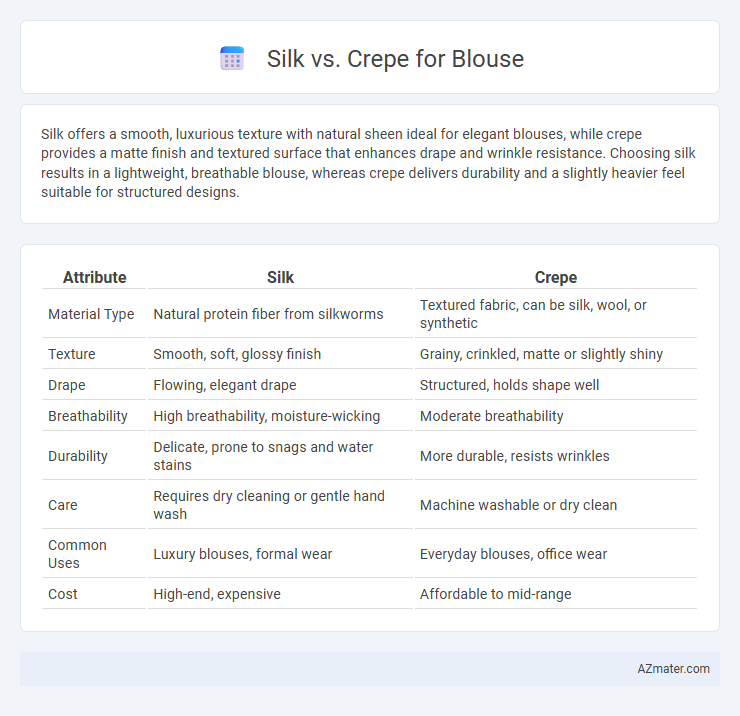Silk offers a smooth, luxurious texture with natural sheen ideal for elegant blouses, while crepe provides a matte finish and textured surface that enhances drape and wrinkle resistance. Choosing silk results in a lightweight, breathable blouse, whereas crepe delivers durability and a slightly heavier feel suitable for structured designs.
Table of Comparison
| Attribute | Silk | Crepe |
|---|---|---|
| Material Type | Natural protein fiber from silkworms | Textured fabric, can be silk, wool, or synthetic |
| Texture | Smooth, soft, glossy finish | Grainy, crinkled, matte or slightly shiny |
| Drape | Flowing, elegant drape | Structured, holds shape well |
| Breathability | High breathability, moisture-wicking | Moderate breathability |
| Durability | Delicate, prone to snags and water stains | More durable, resists wrinkles |
| Care | Requires dry cleaning or gentle hand wash | Machine washable or dry clean |
| Common Uses | Luxury blouses, formal wear | Everyday blouses, office wear |
| Cost | High-end, expensive | Affordable to mid-range |
Introduction to Silk and Crepe Fabrics
Silk, a natural protein fiber produced by silkworms, is renowned for its smooth texture, lustrous sheen, and excellent drape, making it a luxurious choice for blouses. Crepe fabric, characterized by its crinkled or pebbled surface, can be made from silk, wool, or synthetic fibers, offering a distinctive texture and a matte finish that adds visual interest. Both fabrics provide unique tactile experiences and wearability, with silk favored for elegance and crepe valued for its versatility and subtle texture.
Key Differences Between Silk and Crepe
Silk fabric, known for its natural sheen and smooth texture, contrasts with crepe's matte finish and crinkled surface, offering distinct aesthetic and tactile experiences for blouses. Silk is lightweight, breathable, and drapes elegantly, while crepe tends to be slightly heavier with a more structured form and greater wrinkle resistance. These properties influence garment durability, comfort, and suitability for various occasions, making fabric choice crucial in blouse design.
Texture and Feel: Silk vs Crepe
Silk offers a smooth, luxurious texture with a natural sheen that feels cool and soft against the skin, making it ideal for elegant blouses. Crepe features a slightly crinkled, grainy texture that provides a matte finish and a lightweight, breathable feel, perfect for more casual or structured styles. The tactile difference significantly impacts comfort and drape, with silk enhancing fluidity and crepe offering subtle texture and resilience.
Breathability and Comfort Comparison
Silk offers superior breathability due to its natural protein fibers, which regulate temperature effectively, making it ideal for warm climates and prolonged wear. Crepe, while breathable, tends to be slightly heavier and less airy because of its crinkled texture and weave, which can trap heat more than silk. In terms of comfort, silk provides a smooth, luxurious feel against the skin, whereas crepe delivers a more textured surface that may not be as soft but offers greater durability and wrinkle resistance.
Durability and Maintenance of Each Fabric
Silk blouses offer a luxurious feel but require delicate hand washing or dry cleaning to maintain their smooth texture and prevent damage, making them less durable under frequent wear. Crepe fabric, known for its textured surface and wrinkle resistance, provides better durability and easier maintenance, often being machine washable and more resilient to everyday wear and tear. Choosing crepe over silk for blouses enhances longevity and simplifies care, especially for those seeking practical, long-lasting garments.
Appearance and Drapability in Blouses
Silk blouses exhibit a natural sheen and smooth texture that enhances elegance, while crepe blouses offer a matte finish with a subtle, crinkled surface that adds visual interest. Silk drapes fluidly and conforms closely to the body, creating a soft, luxurious silhouette, whereas crepe provides a slightly stiffer drape that maintains structure and shape. The choice between silk and crepe influences blouse aesthetics, with silk emphasizing luminosity and flow and crepe delivering textured depth and form.
Suitability for Different Occasions
Silk blouses offer a luxurious sheen and smooth texture ideal for formal events, evening wear, and professional settings where elegance is key. Crepe blouses provide a matte finish with a slightly textured surface, making them versatile for both casual and semi-formal occasions due to their comfortable drape and wrinkle resistance. Choosing between silk and crepe depends on the desired look and event type, with silk suited for sophistication and crepe favored for practical style.
Price Range and Value for Money
Silk blouses typically range from $100 to $500, offering luxurious softness and natural sheen, making them a premium choice for formal wear. Crepe blouses are more affordable, usually between $40 and $150, providing excellent durability and a matte finish suitable for both casual and professional settings. While silk delivers superior elegance and breathability, crepe offers better value for money through versatility and easier maintenance.
Styling Tips for Silk and Crepe Blouses
Silk blouses exude elegance and pair beautifully with tailored pants or pencil skirts for formal occasions, while their natural sheen can be enhanced by delicate jewelry to create a sophisticated look. Crepe blouses, known for their textured matte finish and versatility, complement both casual jeans and structured blazers, making them ideal for business casual or everyday wear. For styling, choose lightweight silk blouses in soft hues for a flowing, feminine silhouette, and opt for crepe blouses in bold colors or prints to add visual interest and depth to your outfit.
Which Fabric to Choose: Silk or Crepe?
Choosing between silk and crepe for a blouse depends on the desired texture, appearance, and occasion. Silk offers a lustrous, smooth finish and luxurious breathability, ideal for formal wear and elegant draping, while crepe provides a matte texture with a slightly crinkled surface, delivering durability and excellent wrinkle resistance suitable for everyday use. Consider silk for a delicate, high-end look and crepe for a versatile, low-maintenance option that holds shape well.

Infographic: Silk vs Crepe for Blouse
 azmater.com
azmater.com